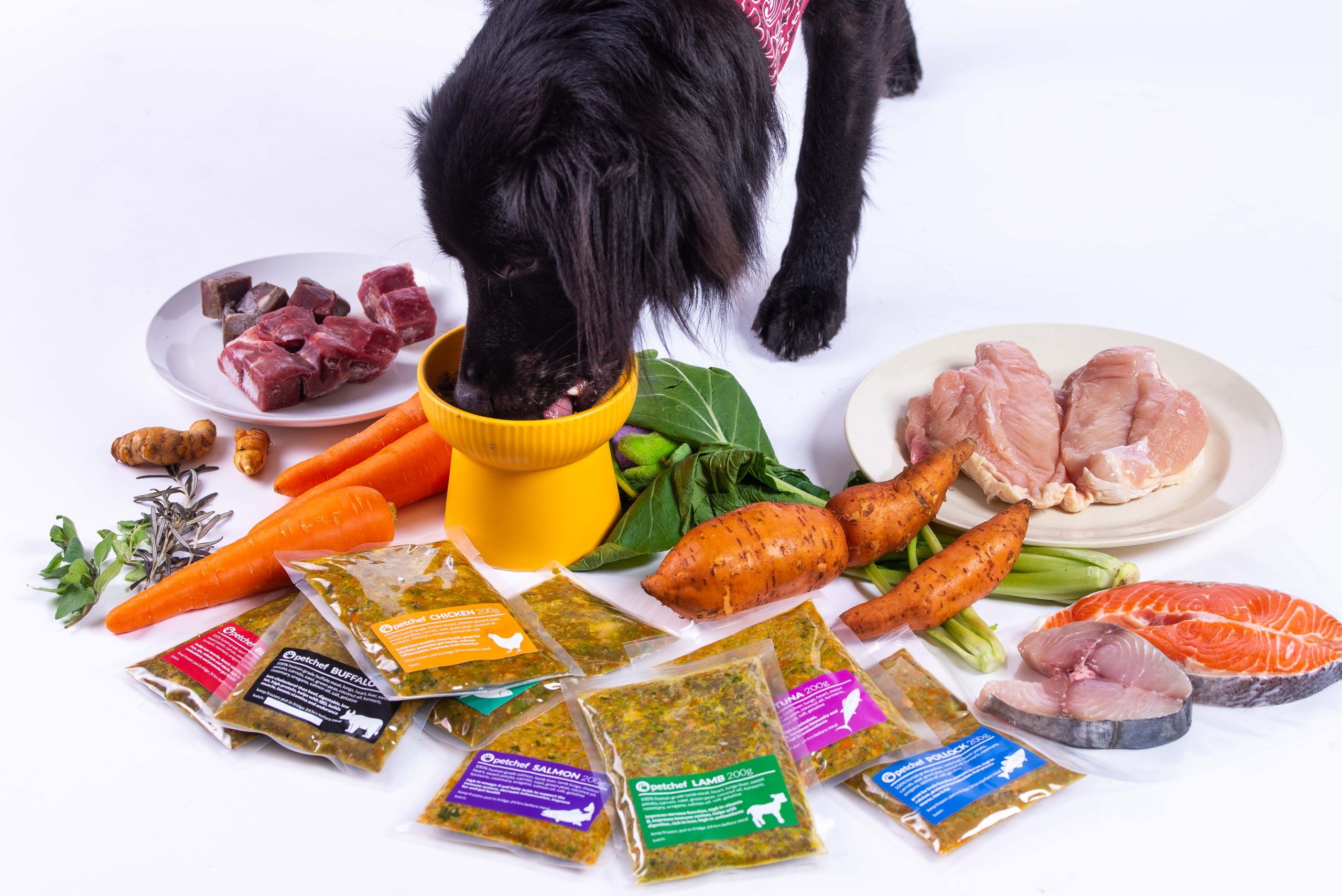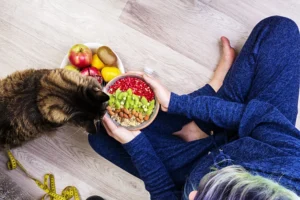When it comes to food, some say that DIY is best. Simply because you’ll know what’s going into the dish and what you’re feeding yourself or your (fur)kids with.
Hence here are some questions our Petchef team has been getting from our beloved customers about preparing and serving fresh pet food to their pets.
What To Feed?
1. Can I put my pet on a vegan/vegetarian diet?
Dogs and cats have had to evolve to become flexible in their feeding strategies to acclimatise to humans. This in turn has helped them develop a stronger, tougher digestive system by being exposed to a wider variety of foods. However, this does not mean that turning vegan or vegetarian is biologically appropriate!
Dogs’ digestive systems are quite capable of digesting and deriving nutrients from fruits and vegetables thanks to their proximity to us humans, but not as easily as digesting animal matter. The necessary amounts of fat and protein the average dog needs will not be found in a vegan/vegetarian diet. Although our research has come a long way, we can confirm that dogs can survive, but probably not thrive on a long term non-meat diet. Cats can only digest a few fruits and vegetables, much less than their canine counterparts, so they would be inapplicable to this kind of diet entirely.
2. Worst case scenario, I’ve run out of fresh pet food and kibble, can I feed my pets zhap fan (economy rice)
Hello, cannot.
Although Zhap Fan typically includes meats, vegetables and egg, herbs and spices like onions, garlic and chives are commonly found in our local cuisines. These herbs and spices along with a higher sodium content are some common household foods that your dog shouldn’t be eating, no matter how they beg!
Hence while it is tempting to feed our pet some sweet and sour pork or minced meat and tofu with chives, an average box of zhap fan is majority rice and highly condimented sauces that can be detrimental to your pet’s digestion.
3. Are additional oils and supplements really necessary?
Our meals consist of freshly sourced and cooked human-grade meats, vegetables, herbs and oils that are nutritionally-balanced and biologically appropriate for both dogs and cats, with no additives or preservatives. Rest assured, if your pet is eating a well-balanced diet, and has no health issues or deficiencies, there’s probably no need to add a supplement to their routine.
Pets who have health issues, or even kittens and puppies who have a deficiency in some key vitamins and minerals, are great candidates for using supplements instead of medications.
However, do your homework. Talk to a professional.
Many times supplements don’t work, are unnecessary, or even, depending on how the supplements interact with your pet and their particular condition, harmful!
PS: Here are 5 main supplements that your dog may need and natural alternatives to add them to their diets!
How To Cook
4. What would a balanced diet for my dog/cat look like?
A balanced diet for dogs and cats would look like this:
For our omnivorous dogs
- 51% meats
- 46% vegetables
- 3% herbs and oils
For our carnivorous cats
- 76% meats
- 6% vegetables
- 3% herbs and oils
- 15% moisture
If you’re thinking of making fresh home cooked food for your furkids, here’s your shopping list! Typically, the ingredients for homemade pet food can be found in our go-to grocery stores (eg: Tesco, Giant, Jaya Grocer, wet markets).
5. What meats should I feed them?
The 4 common proteins are chicken, salmon, beef, and lamb. However, these common ingredients (that are also commonly found in kibble) could actually be an allergen to our furkids due to preexisting or developed intolerances towards the proteins.
Hence, it’s a good practice to rotate or switch up your pets’ meals should they exhibit symptoms of food allergies or intolerance—with the advice of your vet or a pet nutritionist of course.
Here at Petchef, we use 4 uncommon meats namely buffalo, dory, tuna and pollock for their optimal nutrition.
But besides allergies, there are a few other factors to be considered before changing up the meats in your pets food.
- Taste: Not everything tastes like chicken and some dogs prefer stronger smells as they tend to “taste test” the food with their smellers. Try 2 packets of these flavors in your first delivery to test their receptibility towards new meats or fresh food meals!
- Expense: Feeding fresh food to our furkids should not have to cost a bomb. Regardless of whether we’re cooking it ourselves or ordering from a subscription service like Petchef. After all, the aim is to feed our furkids the best and healthiest meals we can afford.
- Quality: More often than not, the quality of meat tops the type of meat fed to your pet. Our human-grade pet meals use meats of higher quality which means that your furkid would be enjoying meats not containing high levels of added hormones or chemicals.
- Health and Needs: Some dogs would be better suited to some meats compared to others. For example, Dalmations would need white meats with low levels of purine but dogs with renal diseases would benefit from red meats with lower phosphorus levels. Should your furkid have any dietary requirements, our friendly Petchef Advisors will be here to assist you in selecting the suitable meal for your dog.
Besides meats, here are 7 other natural ingredients and 6 delicious organs that can add a nutritional boost to your doggo’s meal.
6. Is there a best method to cook my pet’s meal or does it not matter at all? (Eg: baking/boiling/steaming/frying)
If you can choose one ‘cooking method’ that is the best for your pet’s meal plan, we have one word for you: RAW. The difference between raw and any other food preparation is the presence of living enzymes, which disappear in the cooking process. These are proteins only found in raw foods which help the body function: they help restore, repair, and maintain health and are not present in cooked or processed foods.
The only downfall of raw food is that it is:
- Extremely messy
- Commonly requires meals to be fed outside or in an easily cleaned and confined area due to bacteria from raw meat
- Require a very reliable and high quality meat supplier
- Pets may take some time to actually get used to this new diet as it is quite a huge and drastic change
- You still need to ensure that the overall nutrients that your pet is getting from their meals are balanced
Also, living in a tropical climate, it is hard to keep fresh when transporting, making it almost necessary for meals to be store-bought and home-prepared yourself.
How To Feed
7. Can I serve the meal hot and straight from the wok?
While some of us are used to (or enjoy) eating steaming hot food without burning our tongues, it’s best not to serve our pets their food hot. Besides it being a hazard to our pets, their tummies are not evolved to take warm food like us humans. Hence, it’s better to bring down the food to room temperature.
8. Should I be heating up the food to serve my pet?
Absolutely no microwaving or immediate heating! As in all meat products, bacteria is ever-present. If heated suddenly, you can quickly bring meat into the “danger zone” where bacteria multiply the most rapidly, causing smelly, spoiled food.
We would recommend placing a frozen pack of Petchef food in the fridge overnight and further softening it before feeding by placing it in a bowl of water.
“But not hot, not syiok!”
If you need to heat up to activate the yummy smells that are crucial to your pet’s appetite, please cool down before serving. Don’t you worry, they will smell what’s happening in the kitchen and will be more than ready by the time the food is at the appropriate temperature!
9. How many times should I feed my pet a day?
There are many ways to go about this, but we would suggest following these guidelines:
- For kittens and puppies under 6 months: 3 meals a day
- For kittens and puppies 6 months and above: 1-2 meals a day
- For nursing cat and dog mothers: Leave the food outside for them to graze when they need it.
It is important to note that one meal a day can lead to hyperacidity in the stomach which starts after 8-12 hours of no food, which can cause nausea. So please observe your pet. If you notice your pet vomiting bile before its next meal, be sure to feed more meals per day.
Although most experts can all agree that portion size is much more important than the number of meals per day, this all depends on the age, breed, activity level and medical issues of your pet.
How To Store
10. How long can fresh food portions last in the freezer and the fridge?
As a general rule of thumb, any frozen food will keep for three months in a standard home freezer. In the fridge, they will keep for a maximum of 4 days. If opened and kept in the fridge, we advise using a fresh food sealing clip or tie to avoid drying out, cross-contamination or dripping condensation as a rule of thumb food safety strategy.
11. What are some telltale signs that the food has gone bad?
Maybe you left some portions in the freezer and can’t recall when they were received. Upon looking at your freezer and determining whether the portions are good to thaw and eat, there are a few cues:
- You can see some air exposure and/or freezer burn
- Color has changed from when originally received
- It has an unusual odor once thawed and opened
- It has an unusual texture once thawed and opened
- It has been frozen, thawed, and frozen again
- Your freezer is overcrowded, sitting in a frozen puddle of some unknown liquid, or hasn’t been cleaned in an unusually long time
And again, as a general rule of thumb, do not serve if more than three months in your freezer. Better yet, do not serve if you can’t remember when they were last stored in there because chances are, it’s been a long time.
As for any of our treats and oils, please check the expiry date on the packaging to determine whether to eat or to throw!
-//-
Cooking from scratch can be a fun and therapeutic activity as we learn to cook our favs and what’s best for our bodies.
But we also understand that it can be a messy, tedious and time consuming process when you’re a busy adult. Between deciding what to feed yourself and your pet, there’s a multitude of decisions to make.
Hence if you find yourself being too busy to DIY, why not have affordably priced fresh pet meals delivered to you at your convenience?
With a monthly subscription we’ll help you to
- Feed your pet freshly cooked and preservatives-free, human-grade pet food
- Do all the shopping, planning, cooking and cleaning for the food
- Getting the right ratio of nutrients for your pet
All you’ll have to do is tell us all about your pet and our Petchef Advisors will be able to work out a suitable meal plan for you!
Feature Image Credit: Cat Gazette



















